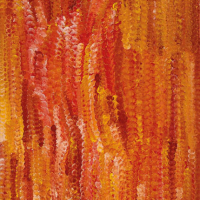42. EMILY KAME KNGWARREYE My Country 1994

Emily Kame Kngwarreye began painting at the age of seventy-nine and in just eight years completed no less than four thousand works of art yet she never went to art school, never looked through art books and rarely went to galleries. Her first experience of serious painting was the making of boldly fluid marks on the greased black skin of her countrywomen. Her artistic achievement, miraculous in its strength and powerful appeal, owes much to the inspiration of Aboriginal spirituality and the magical creation stories that underpin its belief systems.
Despite the considerable international acclaim and fame she achieved during her lifetime, and the vast fortune that she earned and dispensed to her clans people, it is still possible to visualise her sitting by the Alpara store, under the large bloodwood Eucalypts, at the centre of the community. There she would camp and paint on red sandy earth, under a bough shelter, dipping her brush into kerosene tin paint pots, accompanied by a group of relatives. Emily slept under the stars, lived completely indifferent to the mechanisms of wealth and fame, and was largely oblivious to the art of international modernist masters with whom her work was constantly compared.
Her first paintings, created in 1989, were characterised by finely dotted surfaces painted over intimate traditional symbols and linear tracing. As her work progressed, any evidence of underpainting disappeared beneath increasingly gestural fields created by employing larger and larger brushes. A convenient supposition would be that she fell into this style due to the economic imperative of keeping up with market demand. However this discounts the artists genius. With prodigious energy Emily now created wildly colourful canvases by double dipping brushes into pots of layered paint thereby creating floral impressions with alternately coloured variegated outlines. Despite her age, Emilys physicality was evident as she painted, often with a brush in each hand simultaneously pounding them down on to the canvas spreading the bristles and leaving the coagulating paint around the neck of the brush to create depth and form. By the mid 1990s, the runnels of dotted colour across the surfaces of her more abstract works began to be more formally arranged in parallel lines, as in the particularly magnificent work of the period My Country 1994. This work was exhibited in her first international solo exhibition at the Oude Kerk, Amsterdam in 1999 which was opened by Simon Levie, Director of the Rijks Museum. Although Emily created these line paintings as early as 1993 she began working in this style more intensely during the last two years of her life. They gave way to lines of solid colour, stark and unadorned, often painted on multiple panels, powerfully representing the body markings that were created during the ceremonies that were the origins of her artistic practice. Formal compositions comprising solid parallel lines eventually gave way to the meandering paths traced by the roots of the pencil yam as they forged their way through the desert sands. The most magnificent example of this style is the major black and white Yam Dreaming in the collection of the National Gallery of Victoria.
Emily the painter was a bold, unselfconscious force unleashing colour and movement on to canvasses that at their best could be sublime. Her finest paintings are entirely intuitive works, painted during furious sessions in which she never stepped back to look. Painted in the same way as Jackson Pollock (1912-1956); on the ground, but unlike him, crouched over the canvas without even surveying the finished product, such was her assuredness about its content and meaning. Her forceful independent personality, coupled with the strength she developed while working with camels and labouring during her earlier life, was clearly evident as she painted. She worked as if possessed, drawing long meandering lines, bashing out fields of dots with her exceptionally strong hands and arms. She loved getting her hands in the paint as much as the brush as she attacked the canvas.
Emily Kngwarreye was one of Australias three representative artists at the Venice Biennale in 1997, the year following her death, and the subject of a touring retrospective exhibition mounted by Margo Neale for the Queensland Art Gallery. A retrospective exhibition Utopia: The genius of Emily Kngwarreye was mounted by the National Museum of Australia and toured Japan in 2008. By the time she passed away on September the 2nd, 1996, her fame had achieved mythic status. Emily was an artistic superstar, the highest paid woman in the country who had left one of the most significant artistic legacies of our time. The sale of her masterwork Earths Creation I 1995 by CooeeArt Marketplace in 2017 stands as the record price paid at auction for a work of art by an Australian female indigenous artist.
Adrian Newstead